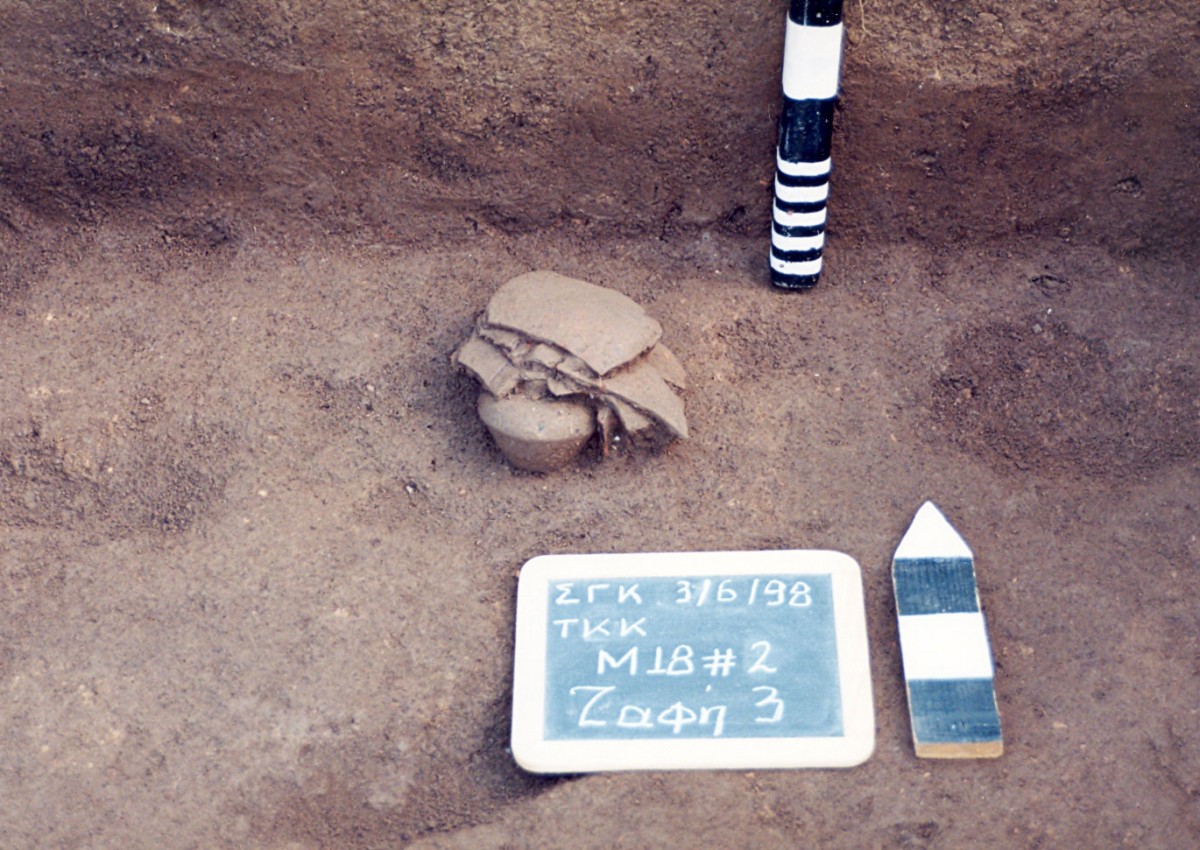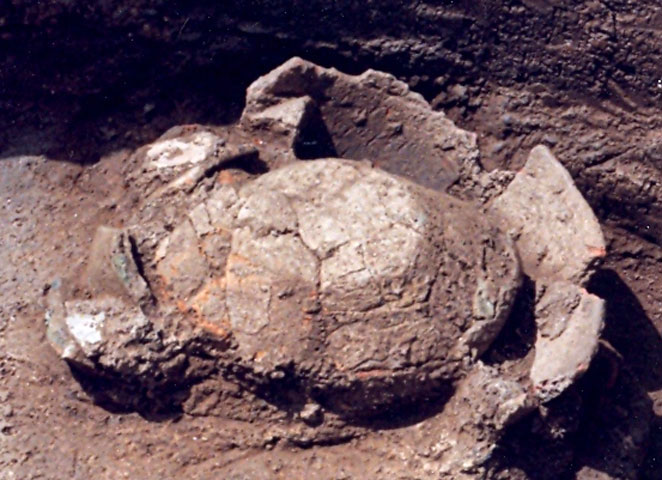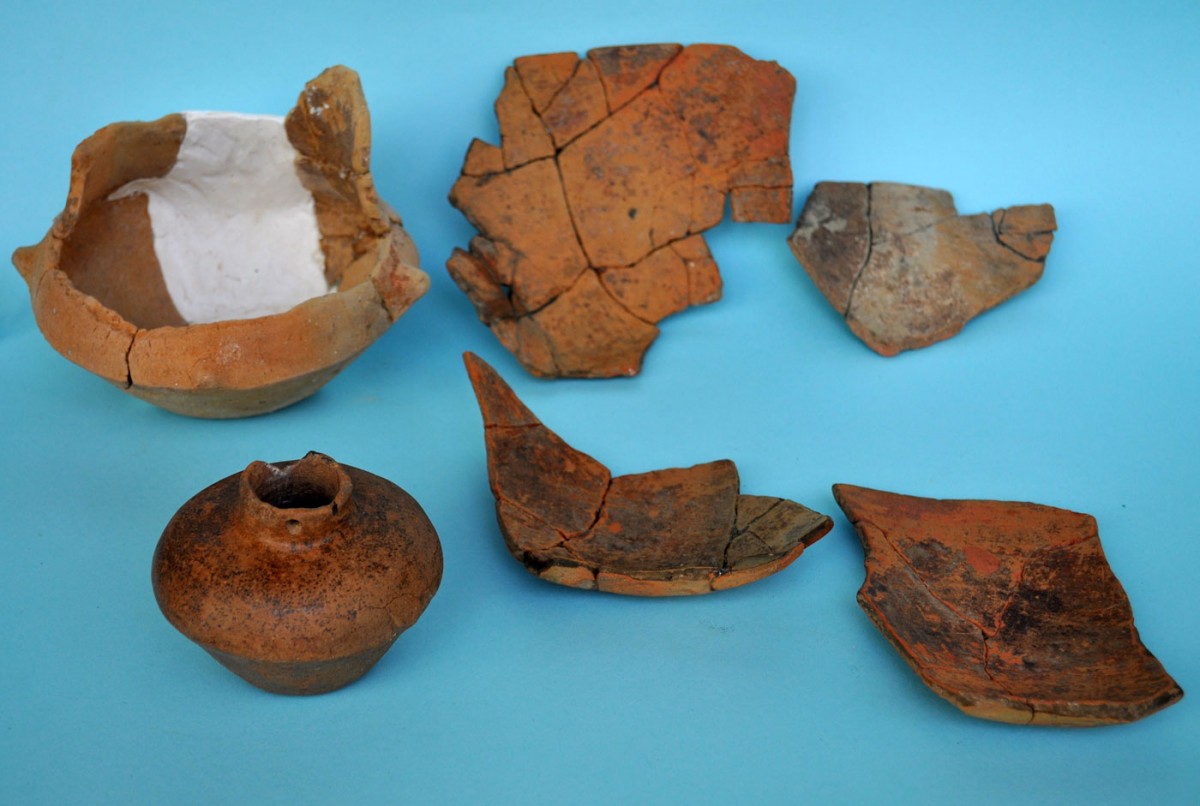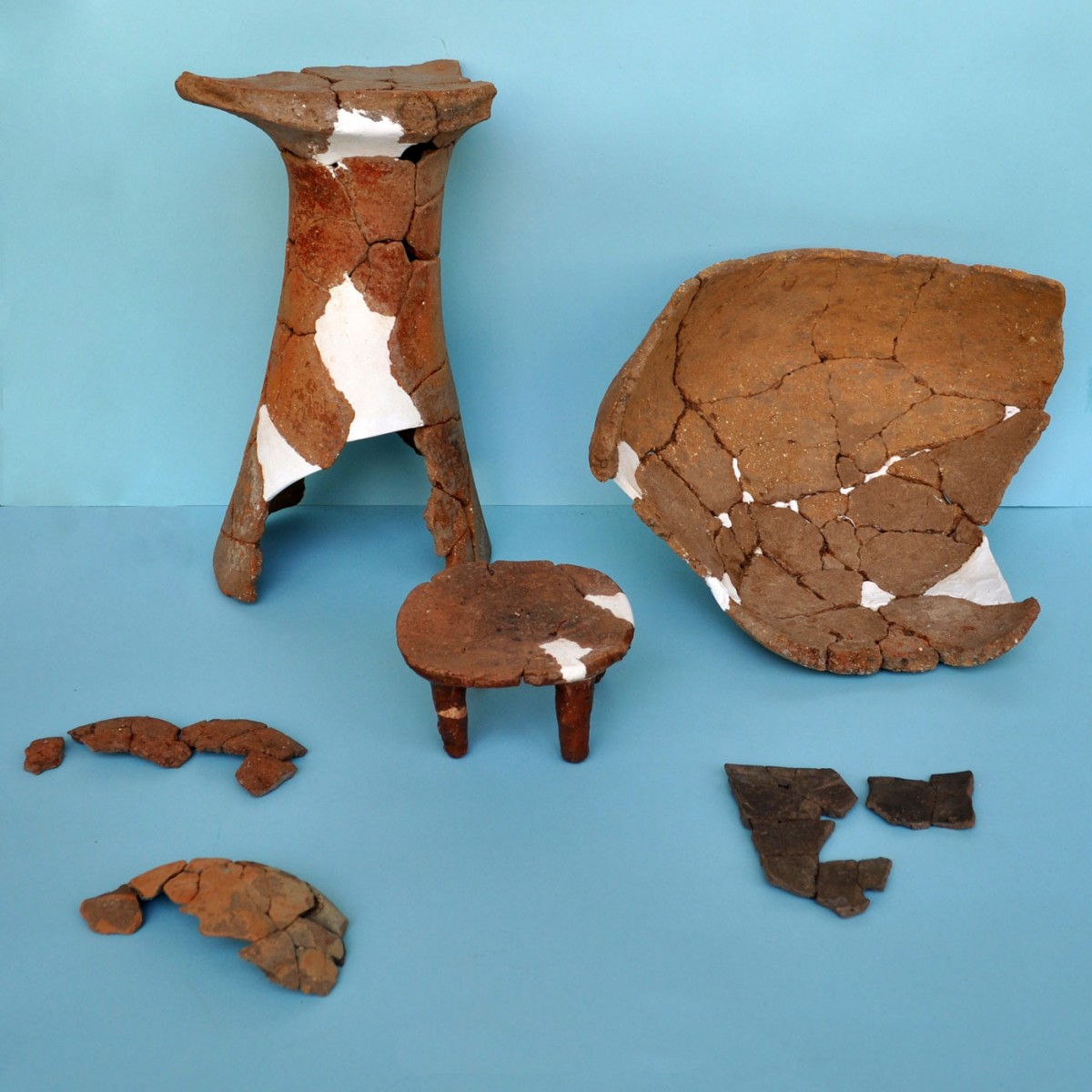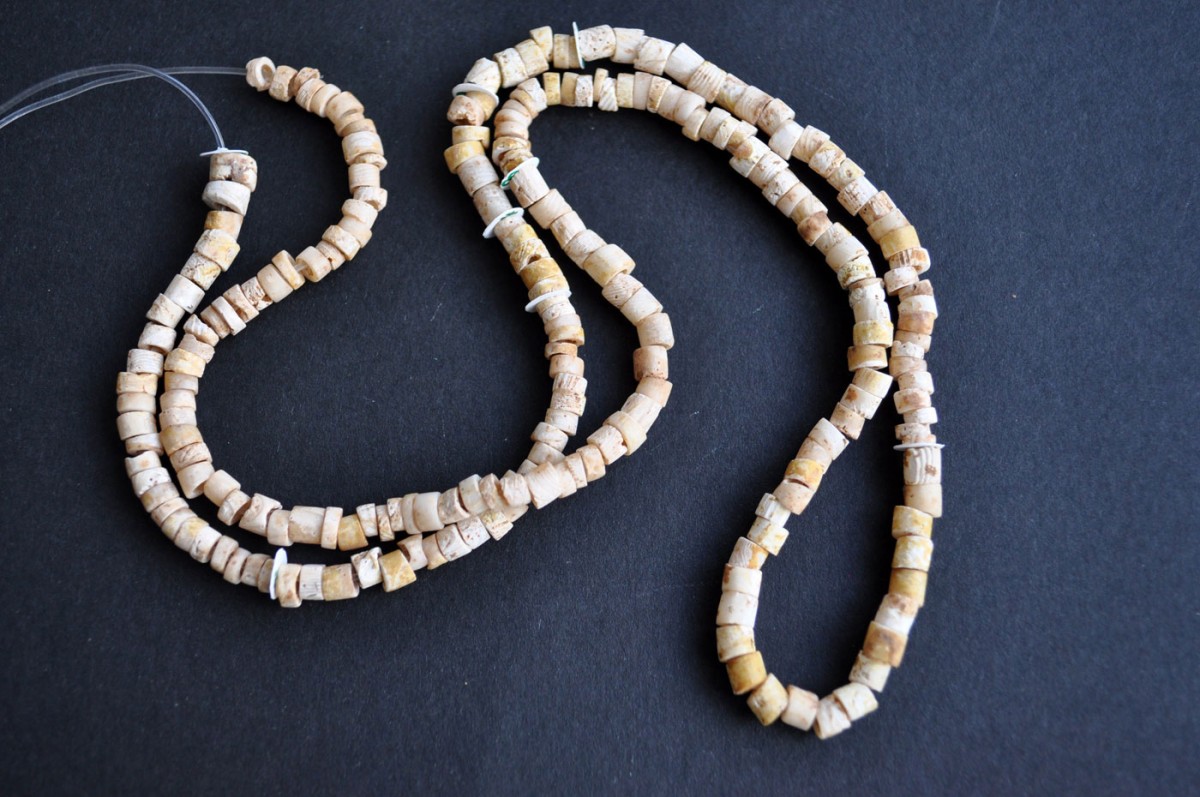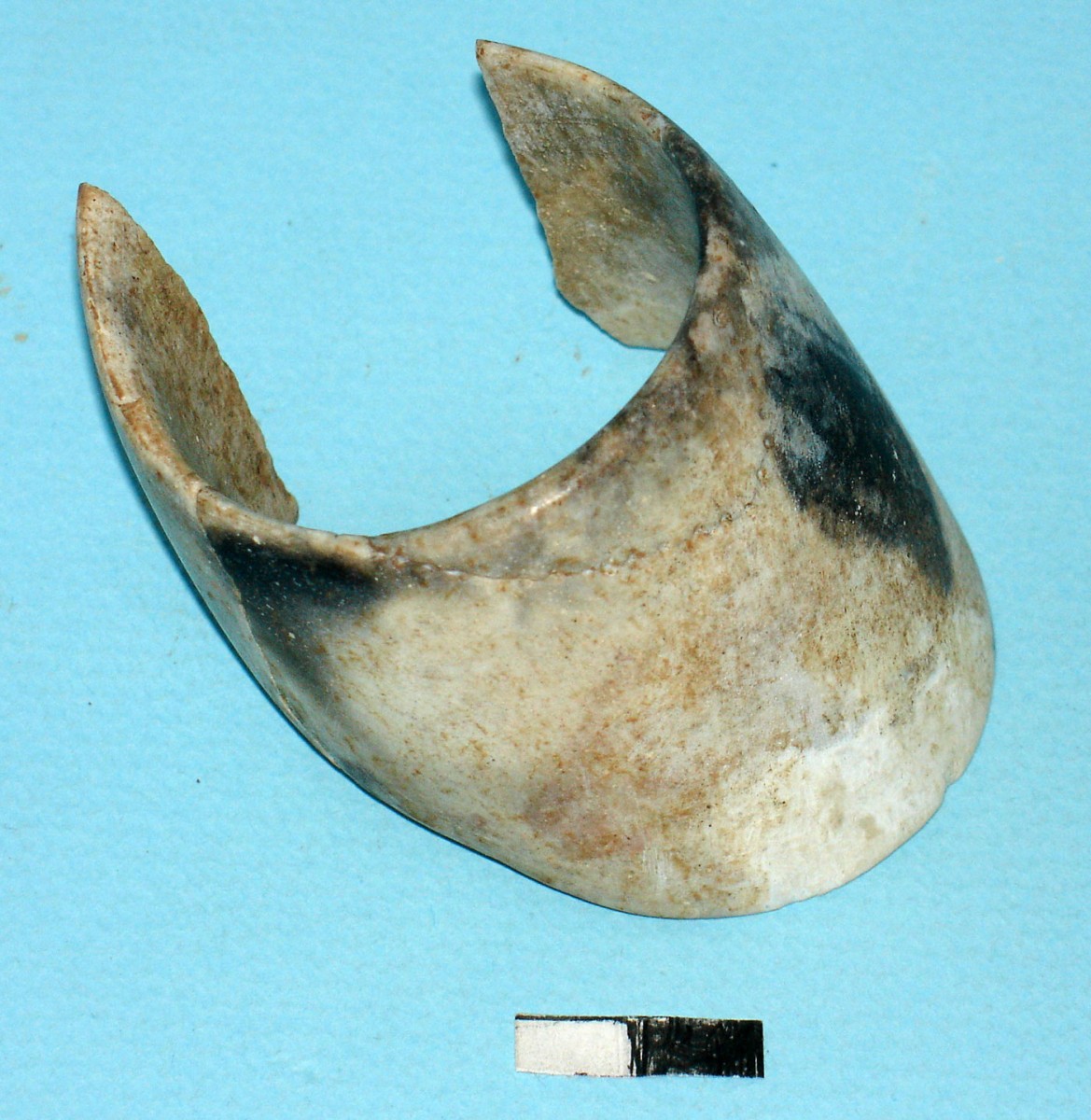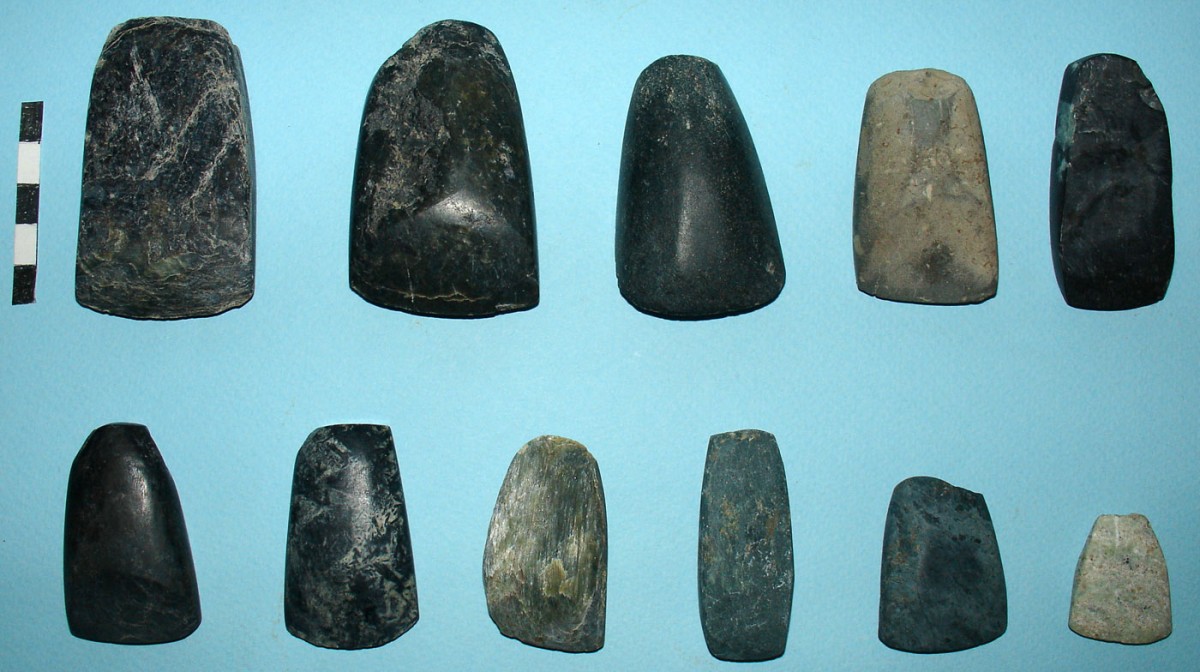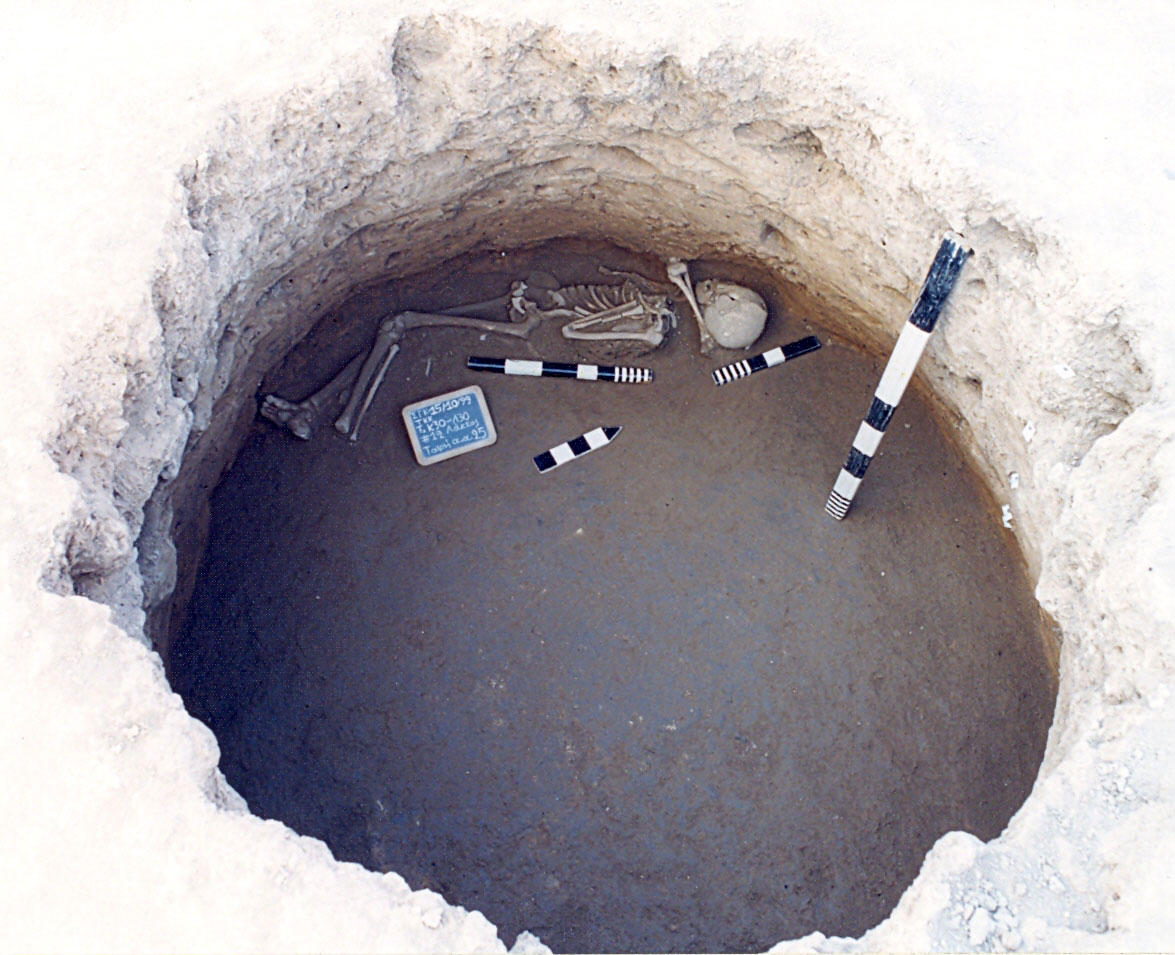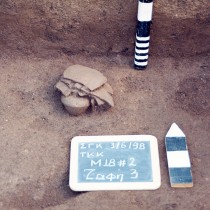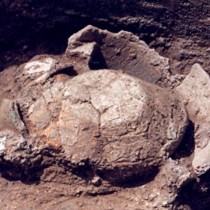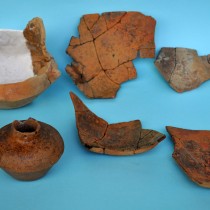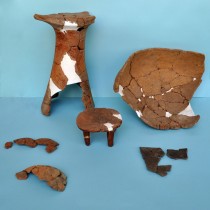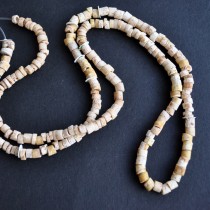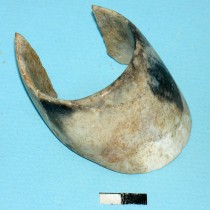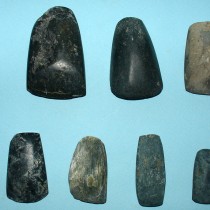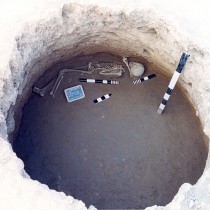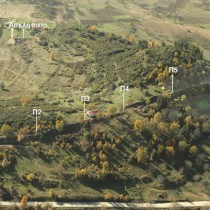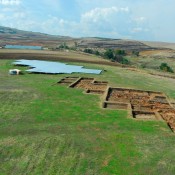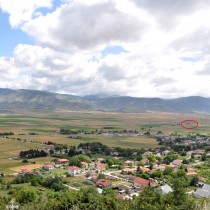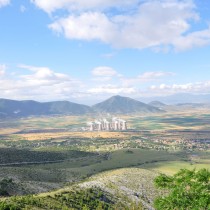Excavation data
Burial remains of the Neolithic settlement of Kremasti can be divided into three categories; a) cremation burials, b) proper interments and c) single human bones. The finds are distributed over all the excavated area and in all the stratigraphic-temporal phases of the site’s use (note 1).
Cremation burial
Cremation as a form of burial has been practiced since the second phase of the excavated area’s use (level C, burial aa 23: the base of a vase with an attached mass of burnt human bones), but is mainly a feature of the final one. The following facts result from the 22 cremations in layer A (burials aa 1-22, figs. 1, 2):
In all cases these are secondary burials: The dead are buried elsewhere and then a small part of the cremation’s remains is transferred to be buried in a particular place, suggesting the use of two separate burial places, namely one for the cremation of the dead and one for the permanent burial of part of the remains. Νο crematoria were located.
Burials are scattered all over the excavated site. Its large area (almost 1.5 acres) and the lack of houses of that same period indicate that it is an extensive organized cemetery for cremations, placed on the settlement’s north east limit, in a district with earlier similar uses of the space, unrelated to habitation. It dates from the end of the pre-Dimini phases of the Later Neolithic period, at the end of the 6th and the start of the 5th millennium B.C.
Burials are found both individually and in clusters, implying a similar social organization.
Burials come in two categories; either elaborate or not. In the first group, these have one or two burial urns and are covered by the shards of one or more vases. The second category includes burials where shards of vases, or parts of them, form a small mound with the deceased’s burnt bones and ashes. These burial assemblages must have been transferred to the spot of the secondary burial, wrapped in some type of cloth or on some stable surface made of perishable material. Burial pits were not found, though, according however to the area’s stratigraphic data, they seem to have been quite shallow, about 0.20m deep.
The cremation burials brought to light 47 vases, 9 of which intact or almost so and 38 parts (either large pieces or shards). The dominant form (31 vases) is that of the flask (phiale) while there is an especially interesting habit of converting, by cutting, large “amphorae” into phialai (4 vases). There are only a few big open vessels (basins or types of storage jar), small closed ones with a neck and “skyphoi”. A table has also been found and part of a “baking dish” (figs. 3, 4).
Apart from the table, the vessels that had been used in the burials are life size and not their miniature copies. They are similar in shape, size and surface treatment to those originating from pits both earlier and of the same period with the burials. They were made to be used in daily life and then they had accompanied the deceased to whom some may have belonged. The role of the flask (phiale) in these burial rituals is so important as to be almost crucial. It appears in almost all the burials and seems to have been ideologically charged. It is characteristic that even larger vases are converted into this shape. Based on all the data of Kremasti, it is possible that the flask could be a symbol of rebirth.
The vases’ very poor state of preservation and the traces of burning they all bare, confirm that these were placed on the fire and burnt with the deceased. The intact vases, especially their large parts, were used as burial urns. Lids were not necessary, while in some cases there were also “accompanying vessels” (or shards) used as offerings. Among these was the table on which some of the necklace beads, obviously worn by the deceased woman, were placed during the cremation.
A feature of cremations at Kremasti is the use of jewellery in burials, which makes the site different from others of that same period in Greece, suggesting a similarity with the Balkans. Out of a total of 415 pieces of jewellery from the excavation (note 2), 285 (69%) are related to cremations. 280 of these (279 beads and part of a ring) are made of sea shells (spondylus) and five of stone. This clear association of jewellery with cremations suggests that the former was part of the deceased’s personal adornment and property which escorted him/her to their final resting place, while the traces of burning observed on some of them confirm that the jewellery were burnt with him/her on the funeral pyre. It is possible that, prior to cremation, they were part of a ritual adornment of the deceased. (figs. 5, 6).
In regards to the rest of the finds, it is worth noting the presence of a stone pickaxe in a burial, most possibly an offering, supporting many researchers’ view on the symbolic function of pickaxes, other than their practical use (fig. 7). The animal bones contained in some burials could be associated with offerings of food to the dead or memory rituals.
Proper burials
These are two interments in pits (burials aa 24, 25).
Burial aa 24 was found undisturbed in the middle of the north section of the excavated area, at a depth of 0.85m from today’s surface. The depth of the burial pit is estimated as 0.40m while its diameter is 1.10m. It is a simple burial pit serving no other function. It dates from the third stratigraphic-temporal phase of the area’s use in layer B. The burial is located on the pit bottom. It belongs to a small child of four (note 3), whose skeleton is preserved in fragments. It appears to have been placed on its left side, with a south-north orientation, its head facing the south. Τhe bones, especially those of the limbs, are quite scattered, which if one excludes their having been disturbed by an animal, makes either for exhumation or in situ burial, with a secondary treatment of the deceased’s bones. The burial was covered with brown coloured backfill. Next to the skull there were a few shards of a vase, while some others were found scattered along with stones and some pieces of baked clay. Two beads were collected from the place, as well as a flint blade and a few parts of stone tools.
Burial aa 25 was located in pit aa 76 (large, egg shaped, for multiple use, with a maximum diameter of 2.40m and a depth of 2m). It is undisturbed and related to the second or third layer of the pit’s use. It is found 2.65m from the space’s present surface and 1.40m from the pit’s original limit, that can be traced to the first stratigraphic-temporal phase of the space’s use (layer D). One can conclude from the discovery of human bones on all layers of the pit that it was used purely for burials and retained its character throughout its life span.
The skeleton is preserved in excellent condition. It belongs to a child of twelve (note 4). The dead boy or girl had been buried at the west end of the pit, along its curved wall, in a small pit opened in the pre-existing backfill, with the former being simultaneously widened to the west. The deceased was placed in a slightly curled up position on its right side, in a north-south direction, its head facing north. The skeleton is 1.35m long, missing the sole of its left foot and parts of the hands, indicating it was slightly disturbed. The burial was covered with a layer of brown grey earth, 0.25m thick, with traces of burning and plentiful finds (shells, animal bones, and many small finds), including a few human bones. Directly under this, two pieces of jewellery were located (two rings made of spondylus shells).
The stratigraphy and the findings under the burial are particularly interesting. The layer in which the burial pit was opened, consists of very hard brown coloured backfill and a quantity of finds (shells, animal bones, an animal skull and several pieces of baked clay from a burnt building on stakes), also including a few human bones. A dog burial (note 5) was found on the pit bottom, 25cm under the burial. No corrosion layer comes between the two sections, which suggests they are separated by a small period of time, while we cannot know with certainty the exact relation between the two burials (human-dog) and the layers next to them and on them.
These two sections of finds (assuming that the burials are part of the layers with the archaeological material) leave many questions unanswered, as they share many features in common. This suggests that the key subject of deposition in both cases is not identified with the burials but with the mass of finds and the human bones placed in the centre of the pit. If therefore we interpret the animal burial as a sacrifice in the context of some ritual, the question regarding the human interment remains.
Single human bones
According to the first data from the anthropological study of the Kremasti material, the recorded bones represent 123 non articulated human skeletons. They originate from various parts of the skeleton, with the long bones clearly predominating. They bear no traces of damage or marks of animals, supporting the hypothesis that the dead were buried from the start and not exposed. The material seems to represent a selective secondary burial of the long bones, a considerable time after the dead had been interred for their bodies to decompose.14 is the minimal number of individuals represented and includes both sexes and all age groups (note 6).
The vast majority of bones come from inside pits of all categories (they were identified with certainty in 46 of these, while it is possible they originate from another 20) and in a few cases from parts of ditches or the backfill of sections (being related to A and B, the two upper levels).
The bones in the pits are linked with 68 layers of use and their common feature is that they contain a great quantity of shells and bones, as well as the occasional baked clay from burned dwellings on stakes. Regarding the small finds, no particular recurring type is observed. These finds also allow us to link the human bones with rituals related to them, as well as connecting the deceased’s initial burial place with the settlement’s habitation space. At the same time, the fact that the layers they originate from are undisturbed, excludes the possibility of disturbance in previous in situ burials. Consequently, what we should state with certainty is that these were not proper interments disturbed by earlier pits being opened or other constructions. Rather, they were bones transferred deliberately from another district to be buried or disposed of in a specific place.
The question asked here is whether this is random waste or material for deliberate disposal. A decisive factor for rejecting the first hypothesis (in some cases at least) is also the identification of human bones in pit aa 387, that contained a great number of intact vessels and a layer of animal bones. Thus, the deliberate incorporation of animal bones in some archaeological assemblages is confirmed, some of which constitute clear cases of deliberate deposition.
A second question is whether and to what degree does the presence in an archaeological assemblage of human bones, as objects of a deliberate deposition, really define the use of the pits that contain them. Or whether these are objects of an equally symbolic, functional and therefore also interpretational value as the rest of the finds making up the assemblage (vases, shells, animal bones, architectural remains/baked clay and small finds). The fact that many of the pits were sealed after this specific use often connected only to a burial (?) seems to suggest some “sanctity” of the content without, however, being sure that this results exclusively from the human bones, since the same thing occurs with other categories of archaeological material. A possible answer to this question would be to connect the opening of the pits with the need to deposit-bury various objects that had completed their life span and were therefore charged both emotionally and ideologically. We could thus argue that it was a cemetery for humans, objects and buildings that all received the same ideological and practical treatment.
In this sense, the assemblages containing human bones could be interpreted, on the one hand, as the remains of funerary rites that took place in the context of exhumation and a secondary burial of selected bones of the deceased. On the other hand, they could be the result of ceremonies in honour of the ancestors, where human bones were also used. In both cases, the site of the first burial of the dead should be sought in another region, outside the excavated area. A very small part of the bones ended up in the burial pit, as well as the objects used in theceremony (possibly including among them personal objects of the deceased or various randomly perhaps selected objects from the habitation area). As suggested by the vases in pit aa 387 (as in the other pits with miniature vessels), some of them were deliberately broken during the ceremony.
Based on this data, we could argue that a number of pits were used either for burials (as a site for proper interment or exhumation), or for rituals (as a site for depositing the remains of a burial ceremony). At least 46 pits certainly contained human bones, pits aa 344 and 11 being two of the excavation’s largest, with elements in the second one that clearly showed that it had originally functioned as a building. The pits were either used systematically (eight of them contained bones on more than one layer) or occasionally and some of the pits for one use had been opened and used only for that purpose. It should also be noted that pit aa 387 stands out from the rest for the quantity and quality of its vases, suggesting cases such as exhumation, a secondary burial of a high born individual and, alternatively, some ceremony related to the community’s ancestors. Moreover, the fact that the “burial pits” are scattered all over the excavated area, while belonging chronologically to all the stratigraphic-temporal phases of its use, is a strong argument in favour of the whole excavated site being labelled as a timeless place of funerary activities.
Regarding the ditches, the few bones that can be connected with certainty to them, since in most cases they seem to have come from earlier disturbed pits, exclude them from being used in burials other than occasionally and after the end of their life span, when they had been filled with rubble.
Summary of the burial data in Kremasti
The following facts result from all the anthropological remains in the excavated area of the Kremasti settlement:
Three ways of treating the dead seem to have been in use in the Kremasti settlement during the pre-Dimini phases of the later Neolithic period; namely, cremations, proper burials and exhumations. The latter seem to have constituted the dominant and timeless burial practice found during the entire use of the specific site for at least 400 years. They consisted of the secondary burial of a very small part of the bones of the deceased (the long bones are usually selected) along with the remains of the ritual that accompanied the event and which seems to have included the slaughter of animals and the consumption of meat by the participants, as well as offerings to the dead. The role played by fire in these funerary rites seems to have been important but not decisive as the remains relevant to them are absent from most cases. The specific mortuary practice concerns both sexes regardless of age. The site of the initial burial of the dead (since the exhibition is not supported by anthropological data), especially of the adults (the presence of two children’s graves perhaps reflects spatial differentiation based on age) is located in another area, unknown to us for the time being.
Pits are used for the primary burials of young individuals but also for the secondary burial of the bones of the deceased, while the use of ditches for burials cannot be argued, based on available data.
During the final phase of the area’s use, cremation of the dead, which had been known in earlier times, seems to have been widespread, without, however, the practice of exhumation being abandoned. Cremation of the dead took place in another district which has not been located.
In both cases (burial/exhumation followed by the burial of selected bones and cremation/burial of remains) the particular place was used only for the second(?)-final stage of the burial rite, that is as a place of secondary and not primary burials. Children seem to be the exception.Αt the same time, the relatively large number of funerary finds, their link with pits of all dimensions and their dissemination throughout all the excavated area lead us to identify the place with a district where part of the settlement’s burial activity is developed (the most important part,perhaps, since it deals with the stage of the final parting of the dead from the living and the transition of the dead to the society of their ancestors).
We cannot know, however, the total area of the region used for burials or whether the researched section was the only place for the secondary burial of the settlement’s dead.
A theoretical approach: Comparisons – Interpretation of funerary data from Kremasti
Burial rites are particular types of social practice, varying from society to society and result from the need to get rid of the dead body. They can be linked not only with the transition from life to death (“funerary rites”) but with the intervention of the ancestors in the world of the living (“ancestral rites”) (note 7).
In general, burial findings from the Neolithic period in Greece and South Eastern Europe are few and disproportionate to the number of located settlements and estimated population sizes. To date, the total number of known Neolithic settlements is small, does not concern all periods and cultures (some of which in fact did not seem to use cemeteries), neither characterizes all the locations of some of them (note 8).
In South Eastern Europe, the use of separate cemeteries, far away from the settlements, dates from the second half of the 6th millennium BC (after 5500 BC, mainly during the 5th millennium BC) (note 9). Since, however, a “location” with concentrated burials is also defined as a cemetery, the earliest known examples come from Thessaly (Soufli, Magoula), are related to cremations and date from the Earliest Neolithic period (approximately 6500-6000 BC) (note 10).
The most common and widespread Neolithic mortuary practice related to the treatment of the body of the deceased, is the interment of the entire body in a curled up or supine position. Matters such as the body’s orientation or position differ considerably, reflecting, among other things, discriminations in gender, age and social groups (note 11).
The practice of cremating the dead had already been adopted since the Mesolithic period. It is timeless and remarkably widespread, related to different peoples and cultures and reflecting various conflicting beliefs regarding death and the afterlife. Some of the burned remains are preserved and buried. The cremation of a deceased is a complex procedure, while in most cases the crematoria have not been located (note 12).
There have also been cases where body parts or dismembered skeletons have been buried, while there is an increasing number of habitation sites where scattered human bones have been found, or fragments of them, not owing to the disturbance of in situ burials (note 13).These finds also suggest the use of a third burial practice of “two phases”, that of secondary burials or exhumations. The dead are first buried in another place (the exhibition is not based on anthropological material, at least in regards to Greece) and then only a small part of their bones is selected for interment (note 14). The phenomenon of scattered human bones has long preoccupied research on the whole of the European Neolithic which covers so much space and time, while essential facts on their interpretation are brought to light by later archaeological research in Greece and the anthropological study of osteological material (note 15).
Burial data of the Late Neolithic from Greece (note 16)
During the Late Neolithic (about 5500-4500 BC), burial finds, compared to the two previous periods (Early and Middle), are increased, while their places of origin are distributed almost all over Greece.
Despite the fact that cremation cemeteries had already made their appearance in Thessaly during the Early Neolithic, since the start of this period there is a distinct tendency to place burials on the periphery of settlements, while it is confirmed that proper cemeteries are used outside and away from them, a custom also continued during the next period of the Final Neolithic, about 4500-300 BC). A few burials, either individual or in small clusters, are located within the settlements.
All the series of mortuary practices known from previous periods is confirmed, while some of them are used simultaneously in the same settlement, such as interments (proper or with discarded skeletons), cremations (mostly secondary with the use of an urn), jar burials, exhumations and human bones scattered in habitation backfills.
Although interment seems to be the most geographically wide spread mortuary practice, it is slightly outnumbered by cremations of the period (due to the existence of cemeteries) while being remarkably dispersed at the same time, with a notable presence in West Macedonia (Anargyroi 3 in Florina [note 17], Dispelio [note 18], Avgi [note 19], Kleitos [note 20], Varemenoi Goulon [note 21]) and in Thessaly (Platia Magoula Zarkos and Soufli Magoula [note 22]). Cremations also appear in Stavroupoli in Thessaloniki (note 23) and Alepotrypa in Mani (note 24).
The burials belong to adults and children who are buried either curled up or stretched out, facing a variety of directions. In Northern Greece they are associated with several of the excavated settlements (Makri [note 25], Stavroupoli [note 26], Makriyalos [note 27], Dispelio [note 28], Pontokomi [note 29], Kleitos [note 30]).
Jar burials are rare (Anargyroi 3 in Florina [note 31]).
Exhumations, partial burials and scattered human bones are encountered in most of the sites in Northern Greece (Makri [note 32], Promachonas [note 33], Stavroupoli [note 34], Makriyalos [note 35], Paliambela [note 36], Anargyroi 3 in Florina [note 37], Dispelio [note 38], Xerolimne [note 39], Kleitos [note 40]) but also in the rest of Greece. This confirms the widespread practice of the secondary treatment of the dead, whether this entailed the second burial of selected bones or their use in possible public burial rituals, in honour of the recent dead or the ancestors. The use of offerings, though very few, is witnessed both in burials and cremations.
Comments regarding the burial of the dead in Neolithic Greece
It has been confirmed that throughout the Neolithic period the dead were directly linked to the area of the living. Organized cemeteries, that are separate and at a distance from settlements, appear (or are witnessed) in the mid-6th millennium BC, while smaller ones, either at the settlement limits or in seasonal uninhabited parts of them, are already encountered in the Early Neolithic. It is, however, considered probable that cemeteries accompanied all settlements and that either they have not been located yet, they cannot be traced archaeologically due to the nature of their remains, or they cannot be recognized as such, because of their form (ditches or streams, for example) and the practice that was carried out. In the cases of individual burials within the settlements, small or larger pits are opened especially for the burial or are used in a secondary capacity for this purpose. It is worth noting the spatial connection between burial areas and houses or storage places and in some cases the morphological similarity between them which supports the hypothesis of “graves representing houses” (note 41).
A series of mortuary practices (interment, cremation, jar burials and exhumation) have already been witnessed since the beginning of the Neolithic period, that are widely spread, different depending on the region and often practiced simultaneously in the same settlement.
Indications of a ritual treatment of the bones of the dead in ceremonies not related to the secondary burial of these particular deceased, are restricted and unconfirmed, dating, however, in their majority, from the Late Neolithic.
Animal bones are usual finds in burial assemblages. The most obvious interpretation links them with food offerings to the dead (note 42), while it is suggested that they may relate to the consumption of food in commemoration rituals (note 43).
The depositing or destruction of vases is especially interesting, found in many burial assemblages, suggesting the deliberate destruction of ceramics as well as the catastrophe –“death” (or sacrifice?) of other objects (note 44). In ethnographic terms, a link is found between death and fertility (note 45). Human sacrifices have not been found in Greece. Only hypotheses can be made for some cases, while clues are also supplied by the rest of Neolithic and Chalkolithic South Eastern Europe (note 46).
The use of stone is a usual ritual practice throughout all the Neolithic era, with a practical and symbolic function (note 47), while various other objects, such as miniature vases and red sea shells (note 48), also had a ceremonial meaning. Offerings are few while it is rare to witness personal pieces of jewellery offered to the dead.
The presence of mounds over the burials is considered very possible in some cases, it can however only be confirmed in a few.
Most indications of burial rituals of a public nature, placed in a particular district of the settlement, are associated with the Late Neolithic followed by the Final.
Comparison of burial data from Kremasti with data from Greece and the greater area of SE Europe
The coexistence of two or more mortuary practices in the same settlement is encountered in many sites in Greece through all the Neolithic period. The reasons for choosing either one or the other practice is a matter for particular research that, in regards to Greece, is still in its early stages.
Cremation as a mortuary practice links the Kremasti settlement both to the region of Thessaly, where cemeteries are encountered and to the greater area of Western Macedonia where the practice seems to have been especially widespread during the Later Neolithic. Examples of cremation from the rest of South Eastern Europe are rare and found in regions far north of Greece (note 49).
All the above cases are isolated secondary cremation burials found inside habitation areas. To date, the only certain cremation cemeteries are found in Thessaly (Platia Magoula Zarkou and Soufli Magoula). In all cases, cremation urns are used, which distinguishes the Late Neolithic period cremations from those of the Earlier Neolithic when human remains were placed in pits. No crematoria were located in any of the cases, suggesting the use of (at least) two burial areas, namely for cremation and secondary interment.
In Kremasti, facts such as the relatively increased number of cremations spread over a large area on the limits of the tell and the lack of clues connecting them to habitations, suggest that it is probably a cemetery outside the contemporary settlement. It resembles cemeteries in Thessaly in a number of details related to the burial ritual e.g. the use of life size burial urns and not their copies in miniature, as encountered in a group of cremation burials in Avgi. It also differs essentially in details such as using parts of vases as burial urns and the presence of jewellery. These features distinguish the Kremasti cremations from those in the Thessaly area, in regards to both the ritual process and the ideology, also suggesting similarities with the Balkans.
Data on cremations in Kremasti offers plenty of important information on the specific mortuary practice of the region. It also confirms the placing of vases as offerings (possibly of food, as perhaps indicated by the few animal bones that were found) in the place where the deceased was cremated, the personal use of jewellery that accompanied the deceased when cremated, the ideological meaning of the flask (phiale), as well as the personal use of pickaxes and chisels which had both a functional and symbolic value.
Very few interments have been brought to light, as is the case in the rest of Greece and the Balkans of that time. As in other regions, they are linked to young individuals, suggesting a possible distinction, based on age, in the treatment of the body.
The use of pits for the interment of the dead is not witnessed in other examples of that time in Greece. It is, however, very common during earlier periods in the greater district of Kitrini Limni and Greece in general, while further North, such examples are fewer and most of them at a later date. Nevertheless, similarities regarding the practice’s logic can be observed in the contemporary primary burials at Makriyalos I located in ditch A, that has the form of pits in a chainlike formation, placed on the settlement’s limits (note 50).
Last, the particularly widespread practice in the Kremasti settlement of the secondary treatment of the bones of the dead is encountered in almost all the Neolithic world, both in Greece and Europe at large. Sites of primary burials differ between settlements and according to the period of time. In Kremasti, the link of almost all single human bones to pits not connected with buildings and simultaneously covering all the period of this specific area’s use, suggests an important burial place on the settlement limits, used continuously over a long time .A direct contemporary of this image is the Makriyalos I settlement and ditch A.
To conclude, the Kremasti burial data supports the differences in the use of space found in Late Neolithic settlements, as well as the use for burials and rituals of places located on the limits of the habitation area. Furthermore, we believe that the considerable number of anthropological remains distributed among many archaeological assemblages could define the use and layout of the region they are found in. The rituals are, more often, about the recent dead, although it is not unlikely that some (or several) of these could be generally associated with ancestors.
Areti Chondrogianni- Metoki
Dr of Archaeology
Head of Ephorate of Antiquities of Kozani
